We looked forward to visiting Denali National Park for the third time in our lives. Fifteen years ago, our first cruise to Alaska included a flight to Fairbanks, and travel by rail back to Anchorage with two nights in a lodge near the entrance to the Park. This allowed Mary Lou and I to take a sightseeing bus some distance inside the park, followed by a long afternoon and evening exploring the beaver ponds and woodlands around our lodge. As we boarded the train back to Anchorage, we decided to return one day, but also allow more time for exploration.
A few years later, in early June, we attended a four night birding program at Camp Denali, accessible by a 95 mile, seven hour ride in a comfortable Camp bus to the end of the Denali Park Road. Our tiny cabin lacked electricity, but had a wood stove, a clean outhouse, and drinking water that was available from a nearby spigot. Situated high on a bluff, we had a cloudless view of 20,320 foot high Mount McKinley (AKA Denali) every day.
At the time of our earlier visits to Alaska, I was not “into” wildlife photography. I carried a point-and-shoot 35 mm film camera. Subsequently, I scanned some of my photos, but lost them after we moved from New Mexico to Florida, when my computer drive failed. I have since been unable to find most of the originals, which included herds of Caribou, a Red Fox running along the road with a Spruce Grouse in its jaws and a shot of Denali, reflected in the still waters of Wonder Lake. Luckily, this photo of a hapless Grizzly Bear survived, though the fate of the bear may be in doubt..
The bear had encountered a Porcupine, and its face was riddled with quills:
When our older daughter suggested that take an RV trip in Alaska soon after the end of the school year, we welcomed the opportunity. It was to be the first visit to Alaska for both of our daughters’ families. Our RV journey through Alaska was primarily an opportunity for a reunion of our two daughters, delayed for a year by the tragic event that had prevented them from getting together a year earlier at our family reunion in Colorado. Because of another unforeseen conflict, our older daughter’s husband also missed our prior family reunion, five years ago in Dallas, and had never met the younger of our two granddaughters. This is a continuation of the story of our Alaska trip that begins at this link.
On our first day northbound out of Anchorage via Wasilla on George Parks Highway (AK-3) we had several clear views of the great cone of Denali, some 80 miles distant, as we approached the turnoff for Talkeetna Camper Park at milepost 98 (taken through the windshield of our RV):
The next day, we paused at a roadside park at mile 135 for a panoramic view of the Denali range, its peak visible just above the clouds:
Our older daughter and her husband greeted us when we arrived at McKinley RV Campground, located at mile 248, about ten miles north of the entrance to Denali National Park.
We occupied adjacent spaces. Their camper is to the right:
We had so much fun reconnecting that there was little time for birding. Indeed, in order to accommodate both of our son-in-laws’ passion for deep sea fishing, we had allowed only one day for exploring the park. We took a 5 hour wildlife tour only 16 miles into the park. The driver provided an excellent interpretation of the history, geology, flora and fauna of the Park.
At the first stop, during an introductory film, I looked out the open door of the theater and saw this (Myrtle) Yellow-rumped Warbler atop a spruce:
The final tour bus stop was at the Savage River, a braided stream with Mew Gulls nesting on its many gravel bars:
Mew Gull at nest:
Two of the Mew Gulls were courting, walking back and forth together in a sort of formal dance routine, which I captured through the bus windows:
They serenely walked together one way, then turned around and walked back:
We spotted three Dall Sheep, more than a mile away on a mountain slope; this was my best image of one:
White-crowned Sparrows were abundant:
The scenery was spectacular, but there were few sightings of big furry creatures to fascinate the children. From inside the bus, I took blurry photos of Snowshoe Hares and one of a distant Caribou.
The Caribou was a male in velvet, resting on the river bed about a quarter mile away:
Lupines were blooming everywhere:
The next morning, on our 400 mile drive south to our next stop on the Kenai Peninsula, we encountered a traffic jam of sorts. A yearling Moose was grazing at the side of the highway, and motorists had pulled over to watch.
We joined the onlookers:
The young Moose paid us little heed, and we continued on our journey:
This was family time, and birding was a secondary pursuit. What a pleasure it was, to share the joy of discovery with our daughters, their husbands and our grandchildren! The birding experience at Denali, while brief, left me with an enduring
image of the tranquil courtship ritual of the Mew Gulls, and a renewed
determination to return to the solace of this great wilderness.
Our next stop: Soldotna, on the Kenai Peninsula
Posted by: Ken @ 9:33 am
We are now back in Illinois after an enjoyable South Central Alaska trip that included camping at Talkeetna, Denali National Park, Soldotna, Homer and Seward. We were accompanied by our two daughters and their families. Our older daughter had suggested an Alaska visit to celebrate a landmark birthday. She also wanted to compensate for her inability to join our 50th Wedding Anniversary family reunion last year, in Estes Park, Colorado. At that time, she and her husband had traveled up from Arizona as far as Colorado Springs, when they learned of the sudden tragic death of his younger brother. Of course, they turned back to be with his family.
We flew out of Chicago with our younger daughter, her husband and their two daughters, ages 6 and 7. The trip got off to an inauspicious start when we discovered that one of our 6 suitcases was never tagged by the curbside luggage check-in clerk. Happily, the crisis was resolved when the clerk found the missing item before flight time. For 10 nights, the six of us shared life in a 32 foot 2011 Winnebago RV.
Arriving in Anchorage late in the evening, we occupied the camper and spent our first night in the parking lot of the RV rental agency. On the next day we drove north about 125 miles to Talkeetna. It was not a birding trip per se, but our plans included wildlife cruises out of Homer and Seward. Mary Lou and I found limited time to look for land birds around the campgrounds.
Our older daughter and her husband had flown in earlier that day and picked up their RV in time to spend their first night at a campground in Denali State Park, and their second night inside Denali National Park. We would meet up with them at Denali on our third night out. Then, another crisis…
Deciding not to carry the extra weight of my notebook computer, I had prepared a detailed itinerary and scanned all the pertinent reservations and receipts, saving them as PDF files in my iPod Touch. Unfortunately, on our second night out, the iPod went dead as a stone after I attempted to charge it with a third-party AC charger. Luckily, I had also copied the entire travel folder into Dropbox, so I was able to read the files on Mary Lou’s laptop whenever we had a WiFi connection. However, such connections were usually non-existent or unreliable, and I will never again be so overly reliant on technology. The only field guide I had brought was the Sibley iPod app, and it was gone for the entire trip. Some of the birds I expected to see, especially pelagic species, would be new or unfamiliar, and this posed a challenge.
Talkeetna is a fairly isolated and quaint village on the Alaska Railroad that is a popular destination for touring companies. A 3/4 mile wooded trail follows along the rail line from our campsite northward to the bridge over the Talkeetna River.
Great Alaskan Railway train in Talkeetna Station, with the trail following along the tracks towards the river:
The trail provided us with a splendid view of the southern Denali mountain chain, about 50 miles to the north:
Next to the RV, a Pine Siskin foraged for seeds that appeared to have collected around a blue tarp:
White-crowned Sparrows were singing all around Talkeetna Camper Park…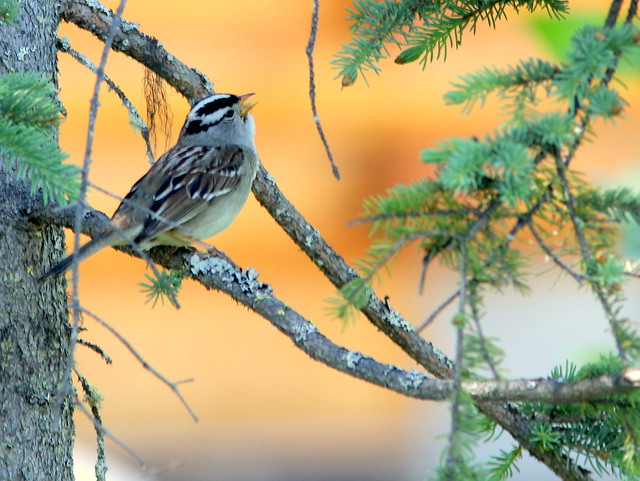
…as were Dark-eyed (Slate-colored) Juncos:
Along the trail, I recognized the “FREE BEER!” call of Alder Flycatchers even without the assistance of a field guide. Most were hidden in the trees… 
…but this Alder Flycatcher sang for me at eye level, clinching its identity as my first “Life Photograph” of the trip: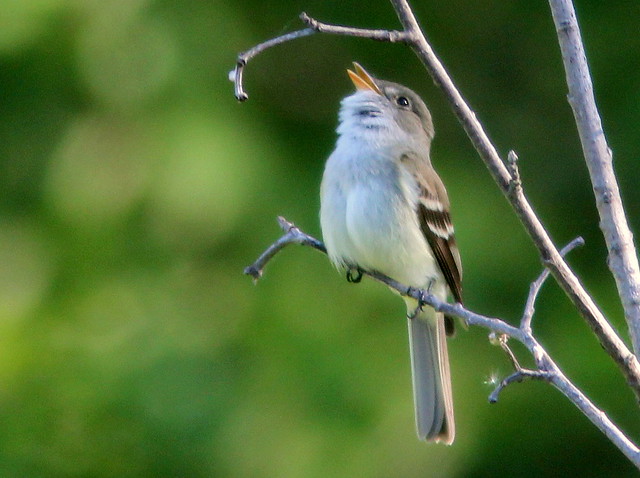
Birding presents many learning opportunities. I was surprised to find that the Yellow-rumped Warblers in Alaska have white throats and light breasts, indicative of the “Myrtle” subspecies of the eastern US; I had expected to see the yellow throat and black chest and upper breast of the “Audubon’s” race which is common in the western part of the lower 48 states
An Internet search revealed that the Audubon’s subspecies (Dendroica auduboni) developed rather recently, during the Pleistocene (10,000 to 20,000 years ago), when glaciation isolated the Myrtle (D. coronata) from the Mexican Black-fronted Warbler (D. nigrifrons). As the glaciers receded, the two populations interbred, and the Audubon’s form may have originated through hybridization between the Myrtle Warbler and the Mexican nigrifrons form (Wiki).
In 1973, on the basis of a limited area of hybridization between the two populations, the American Ornithologists’ Union reduced the number of species in my life list by “lumping” the Myrtle and Audubon’s forms of the Yellow-rumped Warbler into one species. Definition of a “species” is a muddy area, but why does AOU permit Blue-winged and Golden-winged Warblers to be considered as separate species when they hybridize quite freely over a more widespread range?
Recent studies [BRELSFORD, A., MILÁ, B. and IRWIN, D. E. (2011), Hybrid origin of Audubon’s warbler. Molecular Ecology, 20: 2380–2389] have shown the Audubon’s race to be the first visually distinct bird “species” to have hybrid origins. It shares genetic characteristics of both the Myrtle and the Black-fronted Warblers, the latter of which is the Mexican species. “call(ing) into question the validity of these two forms as full species.”
Note the white throat and relatively light breast of this Alaskan “Myrtle” Yellow-rumped Warbler: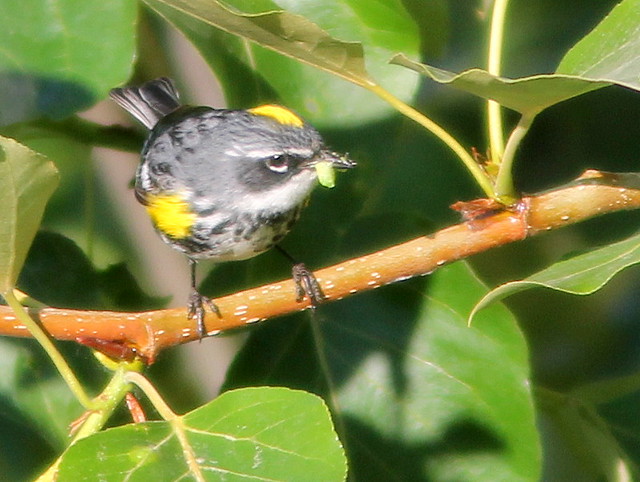
A fledgling Yellow-rumped Warbler waited to be fed:
The female Yellow-rumped Warbler that was feeding the fledgling had a very pale breast:
Violet-green Swallows were numerous; this one perched alongside the trail:
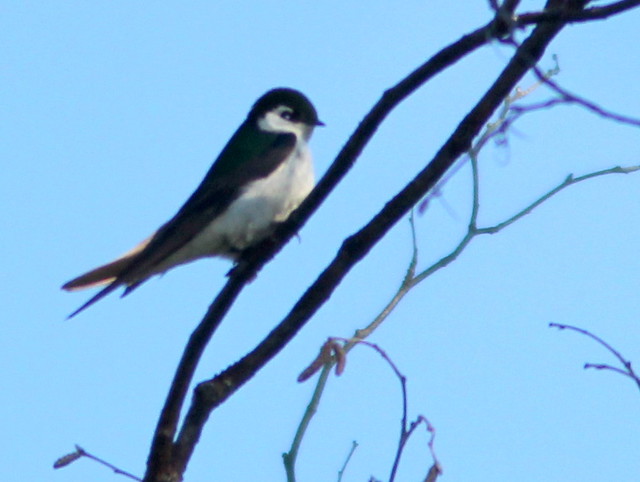
Feasting on dandelion seeds and nearly hidden in the gravel rail bed were Common Redpolls: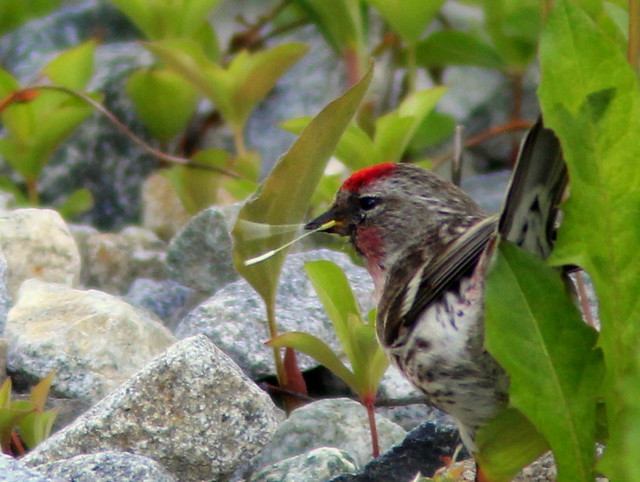
This redpoll perched on a dandelion flower stem:
A nearby fledgling looked like a baby redpoll. There were also Pine Siskins in the trees, so I could not rule out the latter species:
While watching the redpolls, we spotted a cow Moose with two calves along the railroad right-of-way:
We kept our distance as the twins approached us rather inquisitively, with their mother looking on:
I could not overlook the flowers, such as these Blue Bells:
Along the tracks, there were extensive beds of these little four-petaled white flowers of the Dwarf Dogwood:
Wild Irises were fairly common…
Our next stop: Denali National Park







































